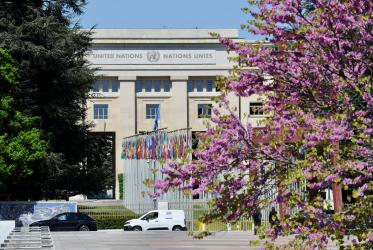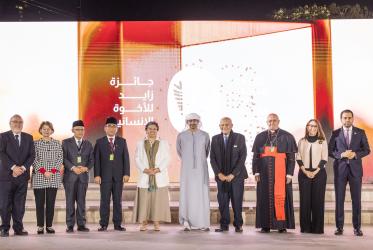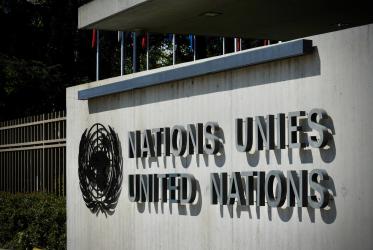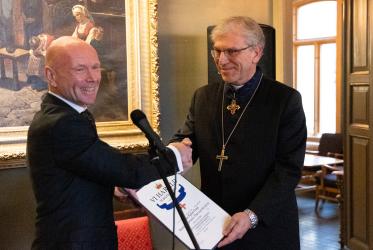Welcoming remarks by the WCC general secretary
Your Excellencies,
Mr Anton Affentranger, CEO of Implenia,
Partners, colleagues, neighbours, ladies and gentlemen,
Welcome to the Ecumenical Centre!
On behalf of the World Council of Churches and its 345 member Christian churches in more than 140 nations, I welcome you to the Ecumenical Centre. This complex houses no fewer than four dozen organizations active in the international community. Many are directly related to churches and world faiths.
We are here to discuss the future, but first let us honour the past.
The Ecumenical Centre was built as a part of “international Geneva” in the first half of the 1960s. It was conceived as a space for dialogue and partnership among churches and others of good will. Its owner, the World Council of Churches, is part of the historic search for Christian unity as a model for seeking a broad and deep sense of unity in the world.
The original construction project was undertaken precisely because the World Council of Churches wished to welcome partners and friends into a common space, like yesterday when we had a great memorial service for Nelson Mandela – also remembering when we invited him after his release from prison in 1990.
Our predecessors hoped that working in close proximity would promote common undertakings and a more vibrant community among members of the various institutions and networks sharing this space.
This vision was shared with the architects and other artists who designed and outfitted the exterior and interior of these premises. It was in the minds of churches and other benefactors who contributed art and materials for use in the building – both at the time of construction and in later years.
For all the advice they received it was the genius of the architects and designers that deserves credit for the look of the grounds, buildings and interiors created in the 1960s.
These artists and engineers came mostly from Switzerland and Scandinavia. The Centre as a whole was the work of the Honegger Brothers, a local firm of well-known architects. Project leader Henri Lesemann, landscape architect Walter Brugger and interior design artist Otto Senn were also based in and around Geneva.
But in that era when “Scandinavian Modern” was a dominant style world-wide, two Danes and a Swede were selected to work with the Swiss team, in particular to design the chapel and the main meeting hall next to it.
Svend Erik Möller of Denmark was the architect for the chapel, and his countryman Knud Ruge Lollesgaard created the stained glass surrounding us. Next door, in the main hall, a monumental tapestry depicting Christ’s prayer for Christian unity, “That they all may be one,” was designed by the Swedish artist Carl Einar Forseth. For all these great visionaries, we give thanks.
The Chapel as the spiritual heart of the Ecumenical Centre
The special features incorporated in the chapel and main hall are a witness to God, and to the world-wide fellowship that we have been called to nurture here.
We are surrounded by gifts from our members and associates – icons and other artworks, musical instruments including Indonesian chimes and an organ donated by the churches of the former East Germany during the years when Germany was divided.
The art reflects various traditions of World Christianity. The wood that you see on the walls and windows, and the original meeting halls, come from a shipment of lumber sent by our member churches in Ghana.
The mosaic icon depicting the Baptism of Jesus, near the chapel entrance, was a gift from the Ecumenical Patriarchate of Constantinople.
In front of it, on the floor, Erik Möller and Otto Senn created a mosaic of their own, continuing the theme of the waters of baptism, so that we symbolically “pass through the waters” as we come to pray together.
Beyond all this, the chapel suggests a sense of “ecumenical movement”. There is a canopy over the central table or altar. The whole ceiling ripples like a great tent – a tent that we would take on a journey, the sort of tent where our ancestors in the faith worshipped on their travels from a land of slavery toward the land of promise. This seems appropriate after our World Council of Churches assembly in Korea last month, when we committed ourselves again to “an ecumenical pilgrimage to justice and peace.”
Combining the global and the local
Our Council has been in Geneva since 1938 although it officially became the World Council of Churches in 1948.
We are delighted to be residents here, we try to be good neighbours, and I believe it is important for us to have this proximity to so many United Nations agencies, to the offices of other international organizations, to frequent sites of conferences where people come from far and wide to share experience and concerns.
At the same time, we reach out to the rest of humanity in all their many locales. Some of us who work in the Ecumenical Centre originate in other cities and countries. The programmes and projects we serve from offices here put down deep roots and form vital connections with people in other lands and cultures. So… We are residents of Geneva, and we are citizens of the world. It is sometimes difficult to balance those twin realities.
As this Ecumenical Centre draws near to its 50th anniversary, we have been contemplating what the future might hold. The question has been, given an aging facility, how best to combine our involvement in global affairs with local needs and prospects.
Sojourners in “international Geneva”
It is no secret that some organizations have had to review their circumstances during financial crises of the past 12 years. There are sound reasons for groups with a commitment to the global South to consider moving there from the north. The impressive strength of the Swiss franc, in particular, raises hard questions for organizations like ours, located in Geneva with income based on currencies of a less consistent fiscal performance.
We have weighed our future carefully. Throughout our discussions, we tried to remain open to diverse ideas, flexible in our responses, and in addition we have wished to have a positive impact on our immediate community, observing ecologically sound principles.
In exploring possibilities, and affirming the advantages of Geneva as a connecting point, we made contact with Implenia. You will hear more about our relations shortly. The exciting thing for me is that, together, we have found reasons to hope for the re-development of the Ecumenical Centre and its surrounding property in ways that will be beneficial to our work, to tenants in this location, to the community of Grand-Saconnex and to the vision for the international zone, as a Jardin des Nations.
The next step – transformation to a Green Village
We will soon hear details of the architectural competition that has been sponsored, and the selection of finalists. Those of us who were on the jury reviewing the submissions for redevelopment of the Ecumenical Centre are grateful for the degree of interest that has been shown in this project. We are also grateful to our partner, Implenia, to everyone on the jury, and to all our advisors as we examined needs, reflected on history, and built consensus for change.
We are excited with the concept of a Green Village, ecologically friendly and inviting, as part of the proposed “Promenade de la Paix” through this part of Grand-Saconnex. We see this as a contribution to the local reality, as well as a space from which to connect with the global reality.
There are further steps to be taken along this journey, and we may encounter the occasional obstacle or unexpected diversion. But that is a part of any pilgrimage – and we are determined to move forward, from this place, toward the goal of unity within a world of justice and peace.




